
|

|
|
Home Site Search Contact Us Subscribe
|
|
|
Small Firm, Global Practice: An Interview with Jim Goring and Andre Straja of Goring & Straja Architects How they manage an international practice as a small firm. By ArchNewsNow June 29, 2010 Jim Goring and Andre Straja met while working at William Turnbull Associates in San Francisco in the late 1980s/early 1990s. In 1996, they formed the partnership of Frank, Goring & Straja Architects, which has since become Goring & Straja Architects. Unusually for a firm whose staff has ranged from 20 to 40 people, Goring & Straja has offices in Rome, Milan, and the San Francisco Bay area. We interviewed Jim and Andre about how they manage an international practice as a small firm.
ANN: How did you start the firm?
Jim Goring: In the 1990s, Andre was director of the Paris office of STUDIOS Architecture. Around 1996, I left Turnbull Associates to start a firm here in the San Francisco Bay area with Tomas Frank, who we also knew from Turnbull. One day, out of the blue, Andre called our office and said, “Hey, let’s be partners.”
Andre Straja: It occurred to me that linking all of us together was a no-brainer, since we knew each other, liked each other, and respected each other professionally. There were no net downsides and only potential upsides. And that's how the thing started.
ANN: How did you structure the partnership in the beginning?
Goring: We share resources. When we work together, we pay each other for each other's services. We don't share profits directly. Perhaps most importantly, we provide a sounding board for one another.
Straja: It's very casual, and it's turned out to be a rather useful relationship in terms of taking advantage of the cost differences. Architects in Italy cost less than those in the United States.
ANN: Because of the difference in labor costs?
Straja: Yes. In Italy, the number of architects in proportion to the general population is much greater than in the United States. But the amount of money spent on construction in Italy is less than a sixth of that in America. So by definition, architects in Italy cost less.
Goring: But labor rates are becoming more similar because of the exchange rate. When we started, the euro and dollar were one-to-one. Now that’s not true.
Straja: The partnership has also been useful in terms of taking advantage of the time difference. In some cases, with two offices, we’ve been able to produce a lot more in relatively less time, working practically 24 hours a day.
ANN: Could you give an example?
Straja: One summer, in late June, I was in Sardinia taking a vacation on a beach, and Jim called. He had been awarded a project to design an auditorium for the U.C. Berkeley business school, and because he needed a quick turnaround, he asked me to take a pass at it. So while he was sleeping, I drew three sketches and sent them to him. He woke up the next morning with three sketches in his e-mail inbox, one of which seemed to be useful to everybody, and eventually led to the design that was built.
ANN: Andre’s work relies more on a crisp modernism incorporating metal and glass. Jim's work seems more eclectic, relies more on timber, and is closer to the Turnbull tradition. Could you talk about your different design approaches and how you reconcile them?
Straja: For one thing, we work in two very geographically different places with completely different traditions. In Northern California, wood is often highly appropriate. In Italy, they are almost allergic to wood. It's not thought of as solid, something that lasts through the centuries. Another reason for the difference in styles is that my STUDIOS experience gave me an entry into the commercial interiors world, while Jim’s work has largely been institutional and cultural.
ANN: How do the two of you work together in terms of a design process?
Goring: Bill Turnbull’s philosophy was that whoever has the strongest idea at the moment, that's the way to go. There is a lot of listening.
Straja: Usually the first step is to decide who the leader of the project is. For example, on a recent project to design a house, Jim set the design direction. In Italy, we helped on the construction document aspects and made suggestions. Jim sent us instructions, and we executed them. On other projects, the roles are reversed.
ANN: Which technologies are useful in this collaboration between two continents?
Goring: The obvious ones – the Internet, Skype, third-party websites where we upload files. We use the same CAD software. Andre's biggest technical breakthrough is more of a story about relationships. He started entering digital renderings in competitions about 10 years ago, long before digital renderings were common. Andre draws everything in two dimensions, then sends the sketches to a three-person firm in Romania that works with us exclusively. They make three-dimensional models of his sketches and e-mail them to another firm in Argentina to be turned into renderings.
ANN: Do you think there are opportunities for other small firms to work globally?
Goring: Yes. There are other small firms engaged in global work. Usually the partners went to school together. I know of one small firm with offices in Oakland, Mexico City, and Sãu Paolo. I think there should be some kind of shared personal or intellectual foundation, whether it is school or work.
Straja: It’s possible if the partners have an international network of people who they know intimately. Large design firms often have global relationships with other firms, but these are relationships of business convenience. When you have personal relationships, it takes on a different dimension. It’s really about having a network of people who can connect because they have worked extensively together for a long time. We know we all share the same commitment to high-quality design. We’re connected not just by our interests, but also by very personal relationships.
Photography: Cesar Rubio Photography; David Wakely Photography |
(click on pictures to enlarge) 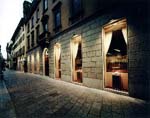 Goring & Straja Studio, Milan Tiffany store, Milan 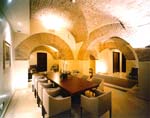 Goring & Straja Studio, Milan Tiffany store, Milan  Cesar Rubio Portola Valley Town Center, Portola Valley, CA 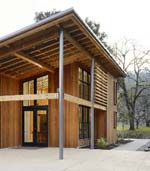 Cesar Rubio Portola Valley Town Center 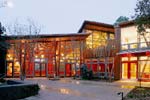 David Wakely St. Stephen's Church, Belvedere, CA 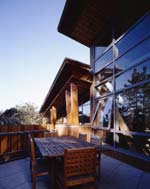 David Wakely St. Stephen's Church 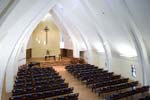 David Wakely Montclair Presbyterian Church, Oakland, CA  Goring & Straja Studio, Milan Affori Center, Milan |
© 2010 ArchNewsNow.com